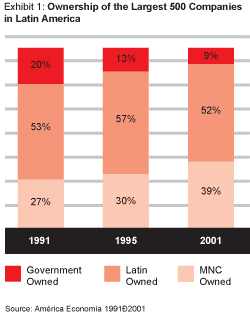As a booster or a sort of“rubber ring” for multinational companies the Economics Section of BBC news in 2012 referred to Latin America because in this region is possible to earn profits that are not possible elsewhere, not even in their country of origin. An increase in consumption and GDP are just among other reasons to explain this phenomenon.

The World Bank stated that in the past decade the middle class hit historic high in Latin America growing 50%, and now representing 30% of the population.
As a booster or a sort of“rubber ring” for multinational companies the Economics Section of BBC news in 2012 referred to Latin America because in this region is possible to earn profits that are not possible elsewhere, not even in their country of origin. An increase in consumption and GDP are just among other reasons to explain this phenomenon.
The article points out that Gilmar Masiero, expert on Internationalization of Companies of the Faculty of Economics and Business Administration of Sao Paolo University, said that in this region there is more economic dynamism than there is in the countries of origin of these companies, that it is more likely to find protection in latin markets and that there is less competition.
“ Latin America is one of the regions were world multinationals expect to grow this year.”
This article also highlighted that according to a survey that the PwC, the biggest firm of professional services in the world, conducted to 1.200 CEOs from the five continents showed that Latin America is one of the regions were world multinationals expect to grow this year.
Facts seem to confirm these assertions. According to the Section of Global Perspective of the Strategy+Business Magazine: “Between 1991 and 2001, the ownership of the 500 largest companies in Latin America changed dramatically, with non-Latin multinational ownership growing to 39 percent from 27 percent”.

Ownership of the largest 500 companies in Latin America. Digital Image. Strategy+business. Pwc. Web 2015. //www.strategy-business.com/article/03307?gko=85c85
According to this magazine, this Multinational Boom took place in Latin America, among other reasons, because of the economic integration and trade accords, including the Mercosur and Andean pacts and the North American Free Trade Agreement (NAFTA). These agreements created regional markets that stimulated trade and investment flows and made it feasible for the first time for companies in Latin America to coordinate operations in adjacent countries to achieve economies of scale and scope.
Foreign Multinational Companies had real incentives to grow their subregional and panregional operations. Also, because GDP and per capita income grew rapidly, as did the size of the middle-and low-income consumer groups that are critical to the growth of global and local companies.
Is it desirable to world multinational companies to come to Latin America? The conditions that previously trigger a boom and that largely beneficiated multinational companies once before are now reaching higher and even historical numbers. The World Bank stated that in the past decade the middle class hit historic high in Latin America growing 50%, and now representing 30% of the population.
Also, liberalization in Latin America is reaching a new level. Latin American Bank of Development analyzed that currently there is not only liberalization in an intra regional level, but a number of countries as Colombia, Perú and Chile have agreements with emerging countries as China and industrialized ones as European Union and United States.
There are also negotiations of Free Trade Agreements with Asian countries and initiatives as the Trans-Pacific Partnership Agreement (TPP) that will particularly change the face of trade and opportunities in a dynamic and fast growing market as that of Latin America.
For example in Colombia, the Colombian Newspaper “El Tiempo” noted that in this country the growing demand on the economy has attracted in just three months at least 35 new multinational companies trough franchise contracts, trade associations and acquisitions. The number considered in the rest of months of the year and in the rest of countries in Latin America show that this region currently is and will increase its interest to foreign multinational companies.
Bibliography:
- Gerardo Lissardy, “America Latina, un flotador para multinacionales”, 15 Frebraury 2012, Rio de Janeiro. //www.bbc.com/mundo/noticias/2012/02/120208americalatinamultinacionalesganancias_crisis.shtml
- Martinez, Alonso, de Souza Ivan. Liu, Francis. Multinationals vs. Multilatinas: Latin America´s Great Race. Fall 2003 / Issue 32 (originally published by Booz & Company), GLOBAL PERSPECTIVE Section, //www.strategy-business.com/article/03307?pg=0.
- World Bank Group, News, FEATURE STORY, Latin America: Middle Class hits Historic High, //www.worldbank.org/en/news/feature/2012/11/13/crecimiento-clase-media-america-latina.
- Miguel Rodriguez Mendoza, Free Trade Agreements in South America. Trends, prospects and challenges. Public Policy and Productive Transformation Series N 7, 2012. //scioteca.caf.com/bitstream/handle/123456789/365/caftomo7_.pdf?sequence=1&isAllowed=y
- El Tiempo with Agencias y GDA , Las marcas extranjeras que llegarán en el 2015, 25 January 2015, , //www.eltiempo.com/economia/empresas/empresas-extranjeras-que-llegaran-en-el-2015/15143796.
